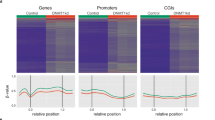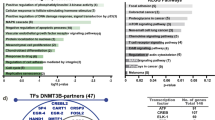Abstract
Adult cancers may derive from stem or early progenitor cells1,2. Epigenetic modulation of gene expression is essential for normal function of these early cells but is highly abnormal in cancers, which often show aberrant promoter CpG island hypermethylation and transcriptional silencing of tumor suppressor genes and pro-differentiation factors3,4,5. We find that for such genes, both normal and malignant embryonic cells generally lack the hypermethylation of DNA found in adult cancers. In embryonic stem cells, these genes are held in a 'transcription-ready' state mediated by a 'bivalent' promoter chromatin pattern consisting of the repressive mark, histone H3 methylated at Lys27 (H3K27) by Polycomb group proteins, plus the active mark, methylated H3K4. However, embryonic carcinoma cells add two key repressive marks, dimethylated H3K9 and trimethylated H3K9, both associated with DNA hypermethylation in adult cancers6,7,8. We hypothesize that cell chromatin patterns and transient silencing of these important regulatory genes in stem or progenitor cells may leave these genes vulnerable to aberrant DNA hypermethylation and heritable gene silencing during tumor initiation and progression.
This is a preview of subscription content, access via your institution
Access options
Subscribe to this journal
Receive 12 print issues and online access
$209.00 per year
only $17.42 per issue
Buy this article
- Purchase on SpringerLink
- Instant access to full article PDF
Prices may be subject to local taxes which are calculated during checkout






Similar content being viewed by others
References
Al-Hajj, M., Wicha, M.S., Benito-Hernandez, A., Morrison, S.J. & Clarke, M.F. Prospective identification of tumorigenic breast cancer cells. Proc. Natl. Acad. Sci. USA 100, 3983–3988 (2003).
Clarke, M.F. & Fuller, M. Stem cells and cancer: two faces of eve. Cell 124, 1111–1115 (2006).
Jones, P.A. & Baylin, S.B. The fundamental role of epigenetic events in cancer. Nat. Rev. Genet. 3, 415–428 (2002).
Jones, P.A. & Laird, P.W. Cancer epigenetics comes of age. Nat. Genet. 21, 163–167 (1999).
Feinberg, A.P. & Tycko, B. The history of cancer epigenetics. Nat. Rev. Cancer 4, 143–153 (2004).
McGarvey, K.M. et al. Silenced tumor suppressor genes reactivated by DNA demethylation do not return to a fully euchromatic chromatin state. Cancer Res. 66, 3541–3549 (2006).
Kondo, Y., Shen, L. & Issa, J.P. Critical role of histone methylation in tumor suppressor gene silencing in colorectal cancer. Mol. Cell. Biol. 23, 206–215 (2003).
Nguyen, C.T. et al. Histone H3-lysine 9 methylation is associated with aberrant gene silencing in cancer cells and is rapidly reversed by 5-aza-2′-deoxycytidine. Cancer Res. 62, 6456–6461 (2002).
Baylin, S.B. & Ohm, J.E. Epigenetic gene silencing in cancer - a mechanism for early oncogenic pathway addiction? Nat. Rev. Cancer 6, 107–116 (2006).
Andrews, D.F., III, Nemunaitis, J., Tompkins, C. & Singer, J.W. Effect of 5-azacytidine on gene expression in marrow stromal cells. Mol. Cell. Biol. 9, 2748–2751 (1989).
Bernstein, B.E. et al. A bivalent chromatin structure marks key developmental genes in embryonic stem cells. Cell 125, 315–326 (2006).
Azuara, V. et al. Chromatin signatures of pluripotent cell lines. Nat. Cell Biol. 8, 532–538 (2006).
Ringrose, L. & Paro, R. Epigenetic regulation of cellular memory by the Polycomb and Trithorax group proteins. Annu. Rev. Genet. 38, 413–443 (2004).
Sparmann, A. & van Lohuizen, M. Polycomb silencers control cell fate, development and cancer. Nat. Rev. Cancer 6, 846–856 (2006).
Vire, E. et al. The Polycomb group protein EZH2 directly controls DNA methylation. Nature 439, 871–874 (2006).
Kuzmichev, A. et al. Composition and histone substrates of polycomb repressive group complexes change during cellular differentiation. Proc. Natl. Acad. Sci. USA 102, 1859–1864 (2005).
Lee, T.I. et al. Control of developmental regulators by polycomb in human embryonic stem cells. Cell 125, 301–313 (2006).
Boyer, L.A. et al. Polycomb complexes repress developmental regulators in murine embryonic stem cells. Nature 441, 349–353 (2006).
Bracken, A.P., Dietrich, N., Pasini, D., Hansen, K.H. & Helin, K. Genome-wide mapping of Polycomb target genes unravels their roles in cell fate transitions. Genes Dev. 20, 1123–1136 (2006).
Schotta, G. et al. A silencing pathway to induce H3–K9 and H4–K20 trimethylation at constitutive heterochromatin. Genes Dev. 18, 1251–1262 (2004).
Tamaru, H. et al. Trimethylated lysine 9 of histone H3 is a mark for DNA methylation in Neurospora crassa. Nat. Genet. 34, 75–79 (2003).
Johnson, L., Cao, X. & Jacobsen, S. Interplay between two epigenetic marks. DNA methylation and histone H3 lysine 9 methylation. Curr. Biol. 12, 1360–1367 (2002).
Jackson, J.P. et al. Dimethylation of histone H3 lysine 9 is a critical mark for DNA methylation and gene silencing in Arabidopsis thaliana. Chromosoma 112, 308–315 (2004).
Fahrner, J.A., Eguchi, S., Herman, J.G. & Baylin, S.B. Dependence of histone modifications and gene expression on DNA hypermethylation in cancer. Cancer Res. 62, 7213–7218 (2002).
Liang, G. et al. Cooperativity between DNA methyltransferases in the maintenance methylation of repetitive elements. Mol. Cell. Biol. 22, 480–491 (2002).
Beachy, P.A., Karhadkar, S.S. & Berman, D.M. Tissue repair and stem cell renewal in carcinogenesis. Nature 432, 324–331 (2004).
Rhee, I. et al. DNMT1 and DNMT3b cooperate to silence genes in human cancer cells. Nature 416, 552–556 (2002).
Herman, J.G., Graff, J.R., Myohanen, S., Nelkin, B.D. & Baylin, S.B. Methylation-specific PCR: a novel PCR assay for methylation status of CpG islands. Proc. Natl. Acad. Sci. USA 93, 9821–9826 (1996).
Pruitt, K. et al. Inhibition of SIRT1 reactivates silenced cancer genes without loss of promoter DNA hypermethylation. PLoS Genet. 2, e40 (2006).
Acknowledgements
Special thanks to L. Meszler (Cell Imaging Core Facility, The Sidney Kimmel Comprehensive Cancer Center), P. Argani (Pathology Department, Johns Hopkins University) and G. Dimri (Northwestern University) for providing the Bmi1cDNA. The pBABE-puro retroviral construct was provided by G. Dimri (Northwestern University). This work was supported by US National Institutes of Health grants CA116160 to S.B.B. and HL073781 to L.C. and National Cancer Institute grant CA043318 to S.B.B.
Author information
Authors and Affiliations
Contributions
J.E.O. and S.B.B. designed this study. J.O., K.M.M., X.Y., K.E.S., H.P.M.,W.C.,V.C.D. and K.P. contributed collaborative experimental results. L.C. and S.G.S. managed the growth and manipulation of ES cells. D.M.B. assisted with characterization of the teratocarcinoma cell explants. D.N.W. and J.G.H. assisted J.E.O. and S.B.B. with data analysis and preparation of the manuscript. L.C. and W.Y. helped with performance and interpretation of microarray results that contributed to the data. T.J. provided antibodies generated in his laboratory for most of the histone modifications studied by ChIP analysis.
Corresponding author
Ethics declarations
Competing interests
The commercial rights to the methylation-specific PCR (MSP) technique belong to Oncomethylome. S.B.B and J.G.H. serve as consultants to Oncomethylome and are entitled to royalties from any commercial use of this procedure.
Supplementary information
Supplementary Fig. 1
Model for how abnormal DNA methylation may be recruited to most tumor suppressor genes in adult cancer cells, reflecting a stem or progenitor cell of origin. (PDF 122 kb)
Supplementary Table 1
Literature references for DNA-hypermethylated genes from Figure 1. (PDF 70 kb)
Supplementary Table 2
PCR Primers and conditions. (PDF 31 kb)
Rights and permissions
About this article
Cite this article
Ohm, J., McGarvey, K., Yu, X. et al. A stem cell–like chromatin pattern may predispose tumor suppressor genes to DNA hypermethylation and heritable silencing. Nat Genet 39, 237–242 (2007). https://doi.org/10.1038/ng1972
Received:
Accepted:
Published:
Issue Date:
DOI: https://doi.org/10.1038/ng1972
This article is cited by
-
Kagami Ogata syndrome: a small deletion refines critical region for imprinting
npj Genomic Medicine (2024)
-
H3K27me3-H3K4me1 transition at bivalent promoters instructs lineage specification in development
Cell & Bioscience (2023)
-
Pan-cancer analysis revealed H3K4me1 at bivalent promoters premarks DNA hypermethylation during tumor development and identified the regulatory role of DNA methylation in relation to histone modifications
BMC Genomics (2023)
-
Regulation, functions and transmission of bivalent chromatin during mammalian development
Nature Reviews Molecular Cell Biology (2023)
-
Metabolic pathway-based molecular subtyping of colon cancer reveals clinical immunotherapy potential and prognosis
Journal of Cancer Research and Clinical Oncology (2023)



